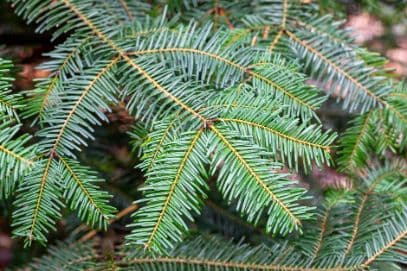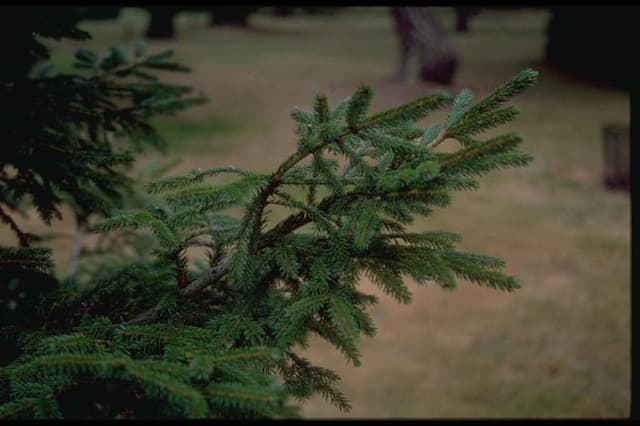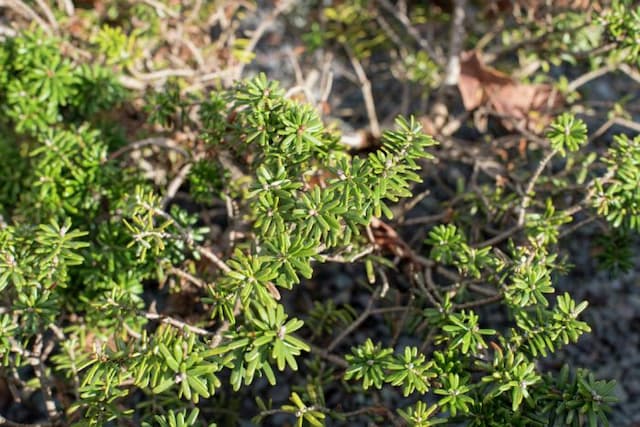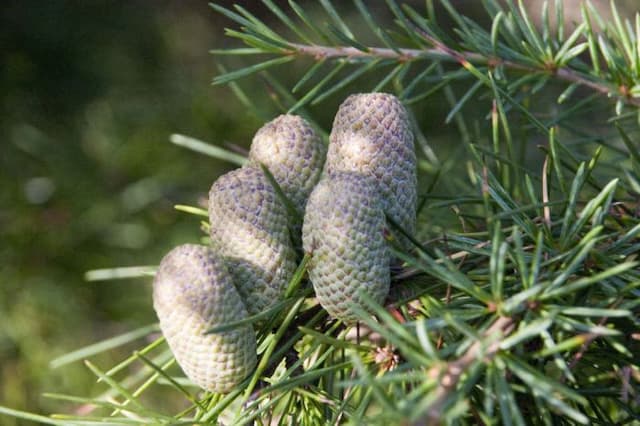Japanese Larch Larix kaempferi 'Blue Dwarf'

ABOUT
The plant known as 'Blue Dwarf' Japanese larch has a distinctive appearance characterized by its striking bluish-green needles. The needles are soft to the touch and radiate in a whorled pattern around the branches, contributing to the plant's lush, dense look. In spring, the needles emerge with a vibrant, fresh hue, which gradually deepens to a more intense blue-green shade as the seasons progress. This conifer is also notable for its attractive conical shape, with branches that are horizontally arranged, creating an overall symmetrical and orderly form. As the seasons change, the 'Blue Dwarf' Japanese larch offers a dynamic display of color. In autumn, the foliage turns to a delightful golden-yellow before it sheds its needles, since it is one of the few conifer species that is deciduous. The bark on the trunk and branches adds further visual interest; it's textured with a flaky, rough surface that is appealing in the winter landscape when the branches are bare. The 'Blue Dwarf' Japanese larch also produces small cones, which begin as a soft green and eventually mature to a woody brown. The cones are diminutive and oval-shaped, adding a subtle decorative touch to the plant. Though small in size, the cones contribute to the overall aesthetic during different seasons. Overall, 'Blue Dwarf' Japanese larch is admired for its seasonal beauty and unique needle color, making it a desirable addition to landscapes seeking visual interest throughout the year.
About this plant
 Names
NamesFamily
Pinaceae
Synonyms
Blue Dwarf Japanese Larch, Blue Dwarf Larch
Common names
Larix kaempferi 'Blue Dwarf'.
 Toxicity
ToxicityTo humans
Japanese Larch is not commonly known to be toxic to humans. There is limited information on the toxicity of this specific cultivar 'Blue Dwarf', but Japanese Larch in general does not possess known toxic compounds that would cause poisoning if ingested. However, as with any plant, individuals may have varying sensitivities, and it is usually advisable not to consume parts of ornamental plants due to the potential for adverse reactions.
To pets
Japanese Larch is not commonly known to be toxic to pets. The cultivar 'Blue Dwarf' is not noted for having toxic properties that would harm animals if ingested. As with their effects on humans, these plants are not considered poisonous to pets such as dogs and cats. However, ingestion of non-food plants can sometimes lead to gastrointestinal upset in pets due to the plant material itself, not necessarily because of any specific toxins.
 Characteristics
CharacteristicsLife cycle
Perennials
Foliage type
Deciduous
Color of leaves
Blue-green
Height
4 feet (1.22 meters)
Spread
3 feet (0.91 meters)
Plant type
Tree
Hardiness zones
5
Native area
Japan
Benefits
 General Benefits
General Benefits- Compact Size: 'Blue Dwarf' is a smaller, more compact variety of Japanese larch suitable for limited spaces in gardens and landscapes.
- Ornamental Interest: This cultivar is prized for its unique blue-green needle foliage, adding visual appeal to the garden throughout the growing season.
- Seasonal Color: It experiences a lovely color transformation in autumn when the needles turn yellow before dropping, providing seasonal interest.
- Low Maintenance: Requires minimal pruning and care once established, making it ideal for gardeners looking for an easy-to-care-for tree.
- Habitat for Wildlife: Provides shelter and potential nesting sites for birds and other wildlife.
- Adaptability: 'Blue Dwarf' is adaptable to a range of soil types, though it prefers well-drained soils.
- Drought Tolerance: Once established, it exhibits some resistance to drought conditions.
- Cold Hardy: It is tolerant to cold temperatures, making it suitable for planting in many temperate regions.
 Medical Properties
Medical PropertiesThis plant is not used for medical purposes.
 Air-purifying Qualities
Air-purifying QualitiesThis plant is not specifically known for air purifying qualities.
 Other Uses
Other Uses- The wood of Japanese Larch 'Blue Dwarf' can be used for crafting small wooden models or sculptures due to its fine grain and workability.
- Its dense growth habit can make it suitable for use in model railway setups or other miniature landscapes as small-scale trees.
- The needles can be collected and used as stuffing material for small, handcrafted pillows or sachets.
- The tree can serve as a living Christmas tree for outdoor decoration due to its conical shape and attractive foliage.
- Dried branches of the Japanese Larch 'Blue Dwarf' can be used for making rustic wreaths or other decorative items.
- The fallen needles can be gathered and used as a natural mulch for acid-loving plants in the garden.
- Japanese Larch 'Blue Dwarf' can be grown as a bonsai, making it a unique specimen for enthusiasts of the art form.
- The distinctive blue-tinted foliage can be used in floral arrangements to provide contrast and a splash of color.
- The resin from the Japanese Larch 'Blue Dwarf' can be harvested and used in making natural adhesives or varnishes.
- Twigs and small branches can be used in the creation of homemade bird feeders or insect hotels to encourage wildlife in the garden.
Interesting Facts
 Feng Shui
Feng ShuiThe Japanese Larch is not used in Feng Shui practice.
 Zodiac Sign Compitability
Zodiac Sign CompitabilityThe Japanese Larch is not used in astrology practice.
 Plant Symbolism
Plant Symbolism- Resilience – Larix kaempferi, commonly known as the Japanese Larch, is a conifer that loses its needles in the fall and grows them back in the spring, symbolizing the ability to recover from hardships and start anew.
- Endurance – As a species that can tolerate cold climates and poor soils, the Japanese Larch stands for perseverance and enduring difficult conditions.
- Renewal – With its cyclic shedding and regrowth of needles, this plant represents the concept of rejuvenation and continuous renewal.
- Beauty in Simplicity – 'Blue Dwarf' is a cultivar appreciated for its understated yet attractive blue-toned foliage, demonstrating that beauty can be found in simple, natural forms.
- Longevity – Larch trees can live for hundreds of years, making them a symbol of long life and immortality.
- Protection – In some cultures, the larch is considered a protective symbol, with its wood historically used to ward off evil spirits when used in construction.
 Water
WaterThe Blue Dwarf Japanese Larch should be watered deeply once a week, allowing for slight drying between waterings. Provide the tree with about 1-2 gallons of water for each watering session, depending on the size of the tree and the weather conditions. During periods of drought or extreme heat, it may need additional water. Adjust the watering frequency to less often during cooler, rainy periods. Ensure the water penetrates the soil to reach the tree's roots, avoiding shallow sprinklings that don't supply enough moisture.
 Light
LightThe Blue Dwarf Japanese Larch thrives best in full sun. It requires at least six hours of direct sunlight daily to maintain its health and stunted growth habit. The ideal spot for this tree is in an open area away from taller structures or trees that could create significant shade.
 Temperature
TemperatureThe Blue Dwarf Japanese Larch is hardy and can withstand a range of temperatures, from as low as -30 degrees Fahrenheit in winter to the high summer temperatures typically found in its hardiness zones. The ideal growing temperatures for this plant are between 60 and 70 degrees Fahrenheit. It should be protected from extreme heat to prevent stress.
 Pruning
PruningPrune the Blue Dwarf Japanese Larch to maintain its shape and size, and remove any dead or broken branches. The best time for pruning is late winter or early spring before the new growth starts. Pruning once a year is usually enough to keep the tree healthy and well-shaped.
 Cleaning
CleaningAs needed
 Soil
SoilThe Japanese Larch 'Blue Dwarf' prefers a well-draining soil mix with a slightly acidic pH of about 5.5 to 6.5. An ideal soil blend would consist of equal parts peat, perlite, and sandy loam to ensure proper drainage and aeration around the roots.
 Repotting
RepottingThe Japanese Larch 'Blue Dwarf' should be repotted every 2-3 years, ideally in late winter or early spring before new growth begins. Younger trees may need repotting more frequently to accommodate their rapid growth rates.
 Humidity & Misting
Humidity & MistingJapanese Larch 'Blue Dwarf' is adaptable to a wide range of humidity levels but thrives best in moderate to high humidity environments, which is often naturally provided in outdoor settings.
 Suitable locations
Suitable locationsIndoor
Provide bright light, cool temperatures, and good airflow for the Japanese Larch.
Outdoor
Place in full sun, provide well-draining soil, and shelter from harsh winds.
Hardiness zone
5-7 USDA
 Life cycle
Life cycleThe life of a Japanese Larch 'Blue Dwarf' begins with seed germination, typically in the spring when temperatures become conducive for growth. The seedling stage is marked by the emergence of the first shoots and roots, as it establishes itself in the soil. Following the seedling stage, the sapling phase sees rapid vertical growth and the development of the conical shape characteristic of this cultivar. As it matures, the Japanese Larch 'Blue Dwarf' enters a long vegetative stage where it develops dense, bluish-green needle-like foliage and a sturdy trunk, with slow but consistent growth over the years. The reproductive stage involves the production of small cones in the spring, following which the plant can pollinate and produce seeds, thereby continuing its life cycle. Finally, after many years, the plant will reach senescence, where growth slows and it may become more susceptible to environmental stresses, before eventually dying.
 Propogation
PropogationPropogation time
Spring-Early Summer
The most popular method of propagating the Japanese Larch 'Blue Dwarf', a variety of Larix kaempferi, is through grafting. This technique involves joining a piece of the 'Blue Dwarf' with the root system of a compatible Larix species, ensuring the desirable traits of 'Blue Dwarf' are maintained. Grafting is best done during the late winter or early spring before new growth begins. To graft, a scion, which is a short piece of stem growth from the 'Blue Dwarf', is cut to include several buds. The scion is then inserted into a cut made in the rootstock, ensuring a snug fit. It is essential that the cambium layers (the growing tissues) of both the scion and the rootstock are aligned. The graft union is then wrapped securely and sealed to prevent desiccation and contamination, with the graft expected to heal and grow within a few weeks.









